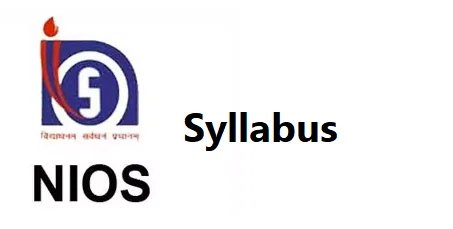syllabus
NIOS Class 12 Biology Syllabus 2024-25

Importance of Biology subject at class 12 level extends from merely board exams and is also important for the candidates preparing for various medical competitive examinations. It is therefore necessary that the students completely familiarize themselves with the Biology syllabus before they start preparation for the exams. The NIOS syllabus consists of different topics divided under 8 core and 4 optional modules. This article provides complete details related to NIOS Class 12 Biology Syllabus 2024-25.
NIOS Class 12 Biology Syllabus 2024-25
Check below the important topics and marks-distribution of the different modules comprised in the Biology syllabus of class 12th.
| Modules | Hours | Marks |
| Core Modules | ||
| Diversity And Evolution Of Life | 25 | 6 |
| Cell, Cell Function And Tissues | 30 | 10 |
| Functional Morphology And Life Processes In Plants | 35 | 11 |
| Functional Morphology And Life Processes In Animals | 35 | 11 |
| Reproduction And Development | 10 | 30 |
| Heredity And Genetics | 10 | 30 |
| Population Explosion And Family Planning | 4 | 10 |
| Environmental Biology | 8 | 15 |
| Optional Modules | ||
| Tools And Techniques In Biology Including Laboratory Techniques | 30 | 14 |
| Economy Biology | 30 | 14 |
| Health Sciences | 30 | 14 |
| Emerging Areas In Biology- Biochemistry, Biotechnology And Immunology | 30 | 14 |
Core Modules
Diversity and Evolution of Life
- Unit 1 Classification of organisms- Principles of classification and taxonomic categories, Linnaeus and binomial nomenclature, general rule for naming, writing and printing of scientific names of organisms, etc
- Unit 2 Viruses- Characteristics of viruses, taking examples of TMV, Polio, HIV, bacteriophage T2
- Unit 3 Scheme of five kingdom classification of organisms
- Unit 4 Kingdom Prokaryotae (Monera)- Chemical nature, general structure and characteristics of bacteria with examples, Mention of useful and harmful bacteria, etc
- Unit 5 Kingdom Protista- General characteristics and classification upto phyla with examples of Amoeba, Entamoeba, Plasmodium, Euglena & Diatoms
- Unit 6 Fungi- General characteristics of fungi, useful and harmful fungi- Yeast, Penicillium notatum, etc
- Unit 7 Kingdom Plantae- Algae- Chlamydomonas, Spirogyra, Bryophyta, Pteridophyta, Spermatophyta, General morphological features of flower and fruit, examples of the following families: Poaceae, Brassicaceae and Leguminosae
- Unit 8 Kingdom Animalia- Main characteristics, classification upto phylum and common examples of Porifera, Coelenterata, Platyhelminthes, Nemathelminthes, Annelida, Arthropoda, etc
- Unit 9 Origin and Evolution of Life- Origin of life- Views, spontaneous generation, experiments of Pasteur, progressive and retrogressive evolution, evidences of evolution, Theories of evolution, etc
Details- NIOS admission 2024
Cell, Cell Function and Tissues
- Unit 1 Cell Structure- Discovery of cell, cell theory, shape, size, physical and chemical composition, generalized cell structure under compound and electron microscopes, differences between animal and plant cell, Cell organelles, etc
- Unit 2 Cell Division- Mitosis and its significance, Meiosis and its significance
- Unit 3 Tissues- Plant Tissues- Meristems-Apical, Intercalary and Lateral- Parenchyma, etc, Animal Tissues- Epithelial, Connective, Muscular and Nervous
- Unit 4 Levels of Organisation (cell to organism)- ascending order of levels of organization- cell, tissues, organ, organ system and organism
Functional Morphology and Life Processes in Plants
- Unit 1 Root- Primary growth, primary structure of dicot and monocot roots, Special features of root for common functions of anchorage, growth in soil, absorption, water conduction and mineral salts, special functions of storage and respiration, etc
- Unit 2 Stem- Primary growth, primary structure of dicot and monocot stem, mode of origin of lateral branches, Growth rings, sap wood and heart wood, Structural features for support, exposing leaves and flowers to favourable positions, etc
- Unit 3 Absorption and Transport- Active and passive absorption, diffusion, osmosis, major theories on transport of water and organic substances
- Unit 4 Nutrition- Macronutrients and micronutrients, Deficiency symptoms
- Unit 5 Leaf- Internal structure of dicot and monocot leaf, Distribution of mechanical tissues, stomata, hairs and hydathodes, vascular tissues, air spaces etc
- Unit 6 Transpiration and Guttation- Processes, magnitude and significance of transpiration and guttation, factors affecting them
- Unit 7 Photosynthesis- Process and significance, Factors affecting photosynthesis
- Unit 8 Respiration- Aerobic, anaerobic, respiratory quotient, factors affecting respiration, fermentation
- Unit 9 Flower and Inflorescence- Parts of a typical flower, flowers in dicots and monocots, arrangement and condition of various parts of flower, Placentation, major types of inflorescence
- Unit 10 Fruit- Definition, major categories, edible parts of common fruits
- Unit 11 Growth and Development- Definitions of growth and development, growth curve, stages of plant growth, photoperiodism, vernalisation hormonal regulation of growth, measurement of growth, etc
Functional Morphology and Life Processes in Animals
- Unit 1 Digestive System- Digestive organs, digestion, absorption, assimilation
- Unit 2 Respiratory System- Respiratory organs, breathing, gaseous transport and tissue respiration
- Unit 3 Circulatory System- Circulatory organs, blood circulation, histology and functions of blood, blood coagulation, blood transfusion, blood groups, etc
- Unit 4 Excretory System- Excretory organs, finer structure of mammalian kidney, ultra-filtration and urine formation, an elementary idea of dialysis
- Unit 5 Nervous System- Central nervous system, peripheral nervous system, autonomous nervous system, sense organs, reflex action
- Unit 6 Skin and skeletal System- Skin- Basic structure and functions of skin, Skeletal System- major bones in human skeleton and their role in protection and/ or, movements, types of joints
- Unit 7 Endocrine system (Chemical Regulation)- Endocrine glands, nature and role of hormones, an elementary knowledge of Pheromones
- Unit 8 Reproductive System- Male and Female reproductive organs, histology of gonads, fertilisation, artificial insemination, ovarian cycle, etc
Reproduction and Development
- Unit 1 Reproduction in non-flowering plants- Reproduction patterns in Escherichia coli, chlamydomonas, Spirogyra, Rhizopus, Funaria, Dryopteris, Pinus
- Unit 2 Reproduction in flowering plants- Juvenility, flowering, flower as a reproductive organ, flower formation and sex expression, pollen and ovule, pollination, fertilization, seed development, fruit development, pathenocarpy
- Unit 3 Vegetative reproduction in plants- Bulb, tuber, rhizome, bulbil, runner, sucker, etc, Special method culture
- Unit 4 Patterns of reproduction in animals- Asexual reproduction by fission, fragmentation and budding, Sexual reproduction
- Unit 5 Basic features of embryonic development in animals- Gametogenesis, sperm and egg, general principles of fertilization, cleavage, blastulation, gastrulation organogenesis, morphogenesis and differentiation
- Unit 6 Embryonic nutrition in birds and mammals (human)- Structure of hen’s egg, role of albumen, yolk and the extra embryonic membranes, Implantation and placenta in humans.
- Unit 7 Some special aspects in Developmental Biology- Growth and regeneration, cancer, ageing
Heredity and Genetics
- Unit 1 Principles of Inheritance- Mendel’s Law of Inheritance, Linkage and crossing-over, criss-cross inheritance
- Unit 2 Gene expression and Interaction- One gene one enzyme hypothesis, Incomplete dominance, lethal genes, pleiotropic genes, Polygenic inheritance with example of skin colour in man
- Unit 3 Physical and Chemical basis of Heredity- Basic structure of DNA and RNA, nucleotides and nucleosides, Functions of nucleic acids, replication of DNA, transcription and translation
- Unit 4 Mutation- Definition of mutation, Mutagens-physical and chemical and their effects, Useful and harmful effects of mutation
- Unit 5 Human Genetics- Problems and modern approach to human genetics, human karyotypes, Autosomal and sex chromosomal abnormalities, Abnormalities due to multiple sets of genomes, etc
- Unit 6 Genetics and Society- Improvement of plants and animals by selective breeding, gene pool, genetic counselling, etc
Population Explosion and Family Planning
- Unit 1 Concept and Definitions- Definitions of population, birth rate, death rate, growth rate
- Unit 2 Trends- Trends in world population and Indian population
- Unit 3 Reasons- Reasons for increased rate of population rise in India
- Unit 4 Consequences of overpopulation
- Unit 5 Control of Population growth- Importance, need for educating both male and female adolescents, higher age of marriage, need for use of contraception
- Unit 6 Methods of Contraception- Reversible Spacing, Natural, Barrier, Hormonal Devices, Devices plus Hormonal, Irreversible Tubectomy, Vasectomy, etc
Environmental Biology
- Unit 1 Ecological Principles- Biotic and abiotic factors in an ecosystem, dependence of plants and animals on their environment, inter-dependence of plants and animals, Man’s place in environment, etc
- Unit 2 Spatial Distribution of plants and animals- Biomes General characteristics of the climate and the flora and fauna of the different biomes
- Unit 3 Conservation and use of Natural Resource- Renewable & Non-Renewable Resources, Primary energy resources & their consumption, fossil fuels, minerals, Soil & Water Conservation, Causes & prevention of soil erosion, fertilizers & manures, etc
- Unit 4 Pollution- Causes, prevention and remedy of different kinds of pollution- air, water, soil, thermal and noise
- Unit 5 Radiation in relation to human life- Kinds of radiation, harmful effects of non-ionising and ionising radiations, etc
Optional Modules
Tools and Techniques in Biology Including Laboratory Techniques
- Unit 1 Short history of invention of simple and compound microscopes
- Unit 2 Basic principle of electron microscope, phase contrast microscope, autoradiography, paper chromatography, tissue culture, centrifugation, etc
- Unit 3 General laboratory equipments- Thermostats, pH meter, autoclave, calorimeter, distillation units, centrifuge, blood pressure instrument, Kymograph, etc
- Unit 4 Preparation of common stains and reagents- Types of stains and reagents, materials required, steps involved
- Unit 5 Maintenance of Botanical garden and Zoological museum aquarium, Herbarium and Green house
- Unit 6 Some techniques- Collection and Methods of culturing organisms for class work, Maintenance of laboratory equipments, Precautions while working in a laboratory, etc
Economy Biology
- Unit 1 Agriculture- Human dependence on agriculture, kinds of Crops, cereals, oil seeds, sugarcane, cotton and jute, Green revolution, farm management, Beverages- Sources, processing and nutritional value of coffee, tea, coco, soya milk, etc
- Unit 2 Mushroom culture, Floriculture and Hydroponics- Brief information about each of these methods
- Unit 3 Medicinal Plants- Concept of general value of plants like Amla, Mahua Cinchona, Atropa belladona, Opium, Datura, Ocimum, Eucalyptus, Neem, etc
- Unit 4 Forest Wealth- Importance of forest, different products-paper, plywood, rubbergums, resin
- Unit 5 Animal Husbandry- General principles of raising and caring of animals, proper management for their products like milk, butter, ghee, meat, wool, leather, Poultry farming
- Unit 6 Fisheries- Fresh water and marine fisheries, Different kinds of common edible fish, their rearing and breeding, Pearl fisheries
- Unit 7 Apiculture and Lac Culture- General Acquaintance with bee keeping and honey extraction, uses of honey and wax, lac insect and lac production
- Unit 8 Sericulture and Vermiculture- Sericulture, different kinds of silk moths, their rearing and silk reeling, Types of silks, rearing of economically useful worms
Health Sciences
- Unit 1 Concept of Health and Hygiene- Definition and meaning of health, need for good health/ concept of ill health, importance of hygiene for maintaining good health
- Unit 2 Nutrition and Health- Nutrition, macro and micro nutrients, sources of nutrients, need for balanced diet, calorific needs of persons in various occupations, nutrition during pregnancy and lactation
- Unit 3 Nutritional disorders- Kwashiorkor, Marasmus, disorders due to mineral deficiency, disorders due to vitamin deficiency, overeating- obesity, risk of intake of overdoses of iron and vitamin
- Unit 4 Dangers of Drug Addiction- Harmful effects of addictive drugs and beverages, rehabilitation of a drug addict
- Unit 5 Hygiene- Types of hygiene- personal, domestic, community, social nuisances like spitting, nose-picking, urination, defecation, throwing garbage and other insanitary habits
- Unit 6 Disease- Disease, definition, types, transmission of disease, parasite, pathogen, infection, infestation, vector, carrier, host
- Unit 7 Communicable Disease– Categories, communicable diseases, causes and common symptoms prevention and control of communicable diseases- Chicken pox, Measles, Hepatitis, Rabies, etc, Transmission of disease during pregnancy
- Unit 8 Non-Communicable disease- Heart disease, Hypertension, Diabetes, Arthritis, Osteoporosis, Cancer and Allergy
- Unit 9 Sexually Transmitted Diseases- Syphilis, Gonorrhea, AIDS- awareness, symptoms and prevention
- Emerging Areas in Biology- Biochemistry, Biotechnology and Immunology
PART A: Biochemistry
- Unit 1 Introduction to Biochemistry- Elements found in living organisms
- Unit 2 Simple biologically important Molecules- water, amino acids, sugars, fatty acids, aromatic bases.
- Unit 3 Macromolecules- Structure and function of carbohydrates, proteins & lipids, Conjugated proteins
- Unit 4 Metabolism of carbohydrates, proteins and lipids Regulation of metabolism
- Unit 5 Translation and Transcription
PART B: Biotechnology
- Unit 1 Uses of biological processes in industry- Use of fermenting yeast to produce alcohol used as beverages and in industry, yoghurt production, use of micro-organisms in production of antibiotics
- Unit 2 General idea of Genetic Engineering- Manipulation of genetic make-up to produce cheap and large-scale proteins, hormones (insulin, blood serum, proteins) and other products of commercial and medical importance
- Unit 3 General idea of Transgenic Organisms- Basic concept of transgenic organisms, Transgenic animals, Importance of transgenic organisms
- Unit 4 Biogas Production- Use of microbes in producing biogas
- Unit 5 Gene therapy in humans- Insertion of good genes into humans to counteract harmful mutation & treat disorder like diabetes, sickle cell anemia, etc
PART C: Immunology
- Unit 1 Introduction- Types of defence mechanisms in the body, Skin, mucous membrane of eyes, nose etc, Immune system
- Unit 2 Tissues and organs involved in the immune system- T cells, B cells, macrophages
- Unit 3 Definition of antigen, antibody- General account of humoral and cell mediated immune response
- Unit 4 Types of immunity- Natural Acquired: active and passive
- Unit 5 Active Immunization (vaccines)- List of available vaccines
- Unit 6 Effect of HIV on immune system
- Unit 7 Definition of Allergens



i need chapterwise iportant questions please
sir can you tell me some important chapters to read please
hii pramila if you want to get important question then you should have guid of biology subject.